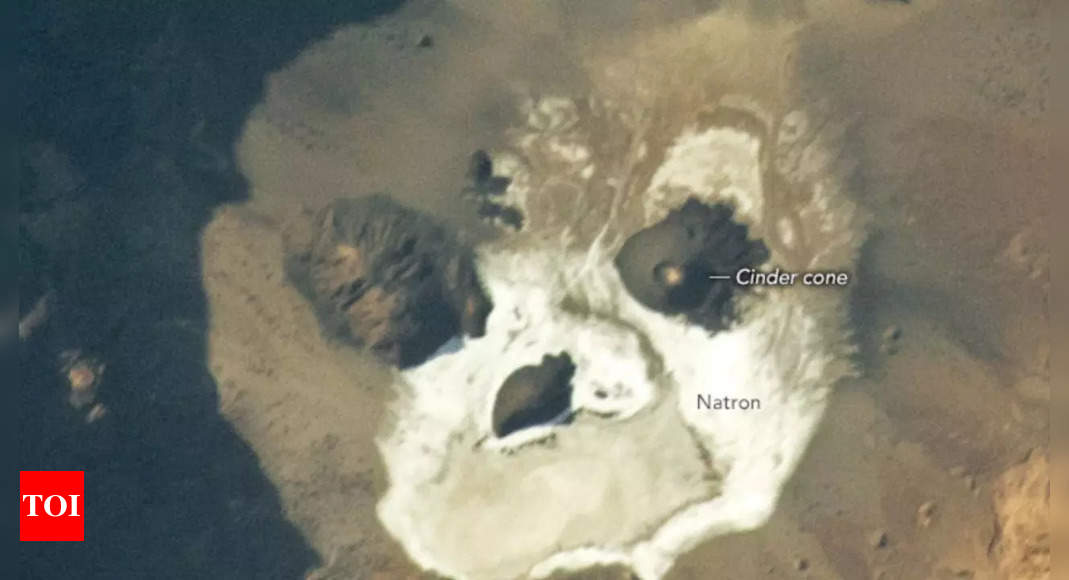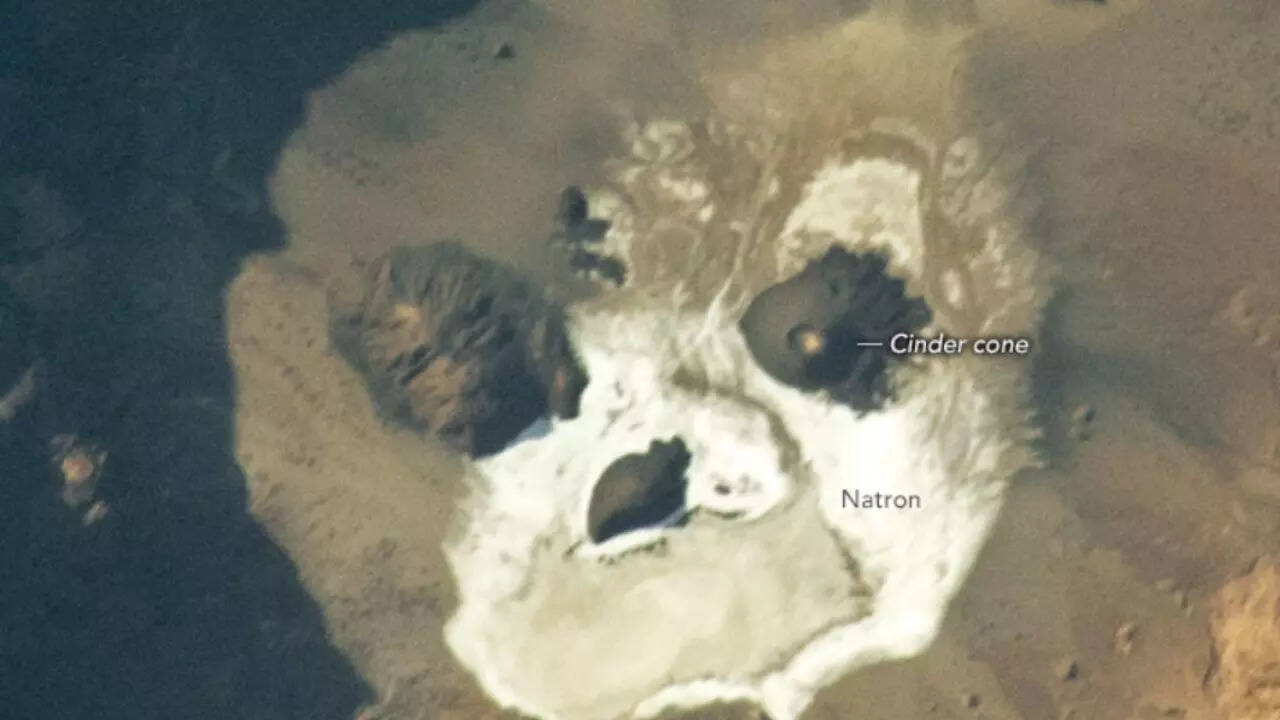NEW DELHI: From space, the Trou au Natron, a 3,300-foot deep volcanic pit and soda lake in northern Chad, resembles a ghostly face staring back. An astronaut on the International Space Station took a photo of this unique feature on February 12, 2023.
The “edge of the face” is partially outlined by shadows created by the rim of a caldera, a volcanic crater formed after an explosive eruption or the collapse of the surface into a partially emptied magma chamber.
According to Nasa Earth Observatory, The “eyes” and “nose” are cinder cones, steep conical hills around volcanic vents. These cinder cones are relatively young in geological terms, possibly forming within the past few million years, and even more recently, possibly in the past few thousand years.
The whitish area around the “mouth” is a mineral crust made of natron, a salt mixture including sodium carbonate, sodium bicarbonate, sodium chloride, and sodium sulfate. This crust forms as hot spring water pools on the surface and evaporates, leaving behind mineral-rich steam rising from the geothermally active region.
Trou au Natron is situated southeast of Tarso Toussidé, a volcanic area with fumaroles and an active stratovolcano. It’s one of several volcanic peaks in the Tibesti Mountains and has been the source of relatively recent, though poorly documented, eruptions.
Due to its remote location, accessing Trou au Natron is challenging for scientists. Nonetheless, rock and fossil samples collected in the 1960s suggest that Trou au Natron was filled with glacial lake about 14,000 years ago.
In 2015, a German researcher Stefan Kröpelin reached Trou au Natron and collected samples of fossilized aquatic algae believed to have formed around 120,000 years ago.
Satellite observations have provided valuable insights into the region’s geological history. Researchers from the University of Cambridge have created a basic timeline of the area’s volcanic events based on observations from the ASTER (Advanced Spaceborne Thermal Emission and Reflection Radiometer) sensor on NASA’s Terra satellite.
They have divided the volcanic activity in the area into six phases, with the formation of Trou au Natron being one of the more recent significant geological events.
Astronaut photograph ISS068-E-53507, taken on February 12, 2023, with a Nikon D5 digital camera using a focal length of 500 millimeters, was provided by the ISS Crew Earth Observations Facility and the Earth Science and Remote Sensing Unit at the Johnson Space Center.
The image was taken by a member of the Expedition 68 crew. It was cropped and enhanced to improve contrast, and lens artifacts were removed, reported Nasa Earth Observatory.
The International Space Station Program assist astronauts in capturing valuable Earth images for scientists and the public, making them freely accessible online.
(With input from agencies)
The “edge of the face” is partially outlined by shadows created by the rim of a caldera, a volcanic crater formed after an explosive eruption or the collapse of the surface into a partially emptied magma chamber.
According to Nasa Earth Observatory, The “eyes” and “nose” are cinder cones, steep conical hills around volcanic vents. These cinder cones are relatively young in geological terms, possibly forming within the past few million years, and even more recently, possibly in the past few thousand years.
The whitish area around the “mouth” is a mineral crust made of natron, a salt mixture including sodium carbonate, sodium bicarbonate, sodium chloride, and sodium sulfate. This crust forms as hot spring water pools on the surface and evaporates, leaving behind mineral-rich steam rising from the geothermally active region.
Trou au Natron is situated southeast of Tarso Toussidé, a volcanic area with fumaroles and an active stratovolcano. It’s one of several volcanic peaks in the Tibesti Mountains and has been the source of relatively recent, though poorly documented, eruptions.
Due to its remote location, accessing Trou au Natron is challenging for scientists. Nonetheless, rock and fossil samples collected in the 1960s suggest that Trou au Natron was filled with glacial lake about 14,000 years ago.
In 2015, a German researcher Stefan Kröpelin reached Trou au Natron and collected samples of fossilized aquatic algae believed to have formed around 120,000 years ago.
Satellite observations have provided valuable insights into the region’s geological history. Researchers from the University of Cambridge have created a basic timeline of the area’s volcanic events based on observations from the ASTER (Advanced Spaceborne Thermal Emission and Reflection Radiometer) sensor on NASA’s Terra satellite.
They have divided the volcanic activity in the area into six phases, with the formation of Trou au Natron being one of the more recent significant geological events.
Astronaut photograph ISS068-E-53507, taken on February 12, 2023, with a Nikon D5 digital camera using a focal length of 500 millimeters, was provided by the ISS Crew Earth Observations Facility and the Earth Science and Remote Sensing Unit at the Johnson Space Center.
The image was taken by a member of the Expedition 68 crew. It was cropped and enhanced to improve contrast, and lens artifacts were removed, reported Nasa Earth Observatory.
The International Space Station Program assist astronauts in capturing valuable Earth images for scientists and the public, making them freely accessible online.
(With input from agencies)

